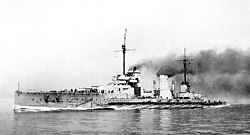SMS Seydlitz
|
||||||||||||||||||
|
||||||||||||||||||
|
||||||||||||||||||
|
||||||||||||||||||
SMS Seydlitz was a large cruiser ( battle cruiser ) of the German Imperial Navy . The ship was named after the Prussian general Friedrich Wilhelm von Seydlitz .
construction
The Seydlitz was a single ship and had no sister ships. In terms of the arrangement and caliber of the heavy artillery, it was a copy of its two predecessors, the Moltke class . It differed from its predecessor ships in that it was built one deck higher in the forecastle area in order to prevent it from being flooded in the high seas. Therefore, the ship was divided over three levels from bow to stern.
Your engine system was designed for a construction output of 63,000 hp for a speed of 26.5 kn. The test drives achieved 89,738 hp. In the literature, the information on the maximum speed achieved varies between 28.1 and 29.1 kn (Breyer, 1970).
The successor ships of the Derfflinger class were a new design, the main artillery of which was placed in the midship line and equipped with 30.5 cm guns. Furthermore, the successor ships were significantly longer with the same width. As a result, they had a slimmer hull and - for the first time in German capital shipbuilding - a smooth deck design. Overcoming sea water should be prevented less by the height of the foreship than by the elongated forecastle and the redesign of the bow shape.
history
First World War
During her first war missions, the Seydlitz shelled Great Yarmouth on November 3, 1914 and took part in the raid on Scarborough, Hartlepool and Whitby on December 16, 1914 . On the second use, she received three hits from land batteries.
Skirmish on the Dogger Bank
In the Dogger Bank Battle on January 24, 1915, she was the flagship of the BdA (Commander of the Reconnaissance Forces), Vice Admiral Franz Hipper . The Great Cruiser Blücher , the last ship on the German keel line , was sunk in the process, and the Seydlitz received a serious hit in one of the aft turrets , which caused a cartridge fire. Only by flooding the aft ammunition chambers quickly could an explosion of the propellant charges and thus the complete destruction of the ship be avoided. The pump master Wilhelm Heidkamp saved the rest of the team from greater misfortune when he opened the glowing pump valves, although his hands were badly burned, which made it impossible to return to his job as a fitter.
Bombardment of Lowestoft and Great Yarmouth
At noon on April 24, 1916, the Seydlitz ran as the flagship of an association of Rear Admiral Friedrich Boedicker to the east coast of England to bombard Lowestoft and Great Yarmouth . At around 4 p.m. she was hit by a sea mine near Norderney and badly damaged, and eleven crew members were killed. While Boedicker switched to the Lützow and continued the company, the Seydlitz returned to Wilhelmshaven, accompanied by two torpedo boats and the airship L 7 , where it was repaired until May 29th.
Battle of the Skagerrak
On May 31, 1916, the Seydlitz took part in the Skagerrak Battle as the second ship in Hipper's 1st reconnaissance group. Here she was able to sink the British battle cruiser Queen Mary together with the Derfflinger . In the battle the Seydlitz received 21 heavy hits as well as two hits of medium caliber and also a torpedo hit in the forecastle. With around 5,300 tons of water on board and badly damaged, she was only able to return to Wilhelmshaven on June 1, 1916 with great difficulty . At times, it even had to be driven backwards because the forecastle was already so under water that the deck was flooded.
Scapa Flow
According to the terms of the armistice, most of the German deep-sea fleet had to be interned by the Allies. On November 19, 1918, the ship with the German internment association was moved to the British naval base Scapa Flow . When the victorious powers decided in Versailles to finally surrender the fleet, it was decided that the Imperial High Seas Fleet would submerge itself in Scapa Flow in order not to let it fall into the hands of the enemy. The crew of the Seydlitz sank the ship on June 21, 1919 by opening the sea valves. It capsized to starboard , with the hull partly remaining above water because of the shallow depth.
Whereabouts
The wreck was lifted in November 1928 and scrapped in Rosyth by 1930 . A Seydlitz gun barrel damaged in the Battle of the Skagerrak was erected in front of the Wilhelmshaven Garrison Church after the First World War . Today it is in the German Naval Museum . The ship's bell is kept in the Naval Memorial Laboe .
photos
See also
literature
- Klaus Gröbig: Large cruiser SMS Seydlitz. In: Ships people fates. Issue No. 155/156, Verlag Rudolf Stade, Kiel 2007.
Web links
- deutsche-schutzgebiete.de
- Newsreels recording the British Pathé on 13 May 1929, film clips from the raising of Seydlitz at Scapa Flow
- This is how the revolution went on the battle cruiser "Seydlitz"
References and comments
- ↑ The Navy named the destroyer Z 21 Wilhelm Heidkamp after him.








